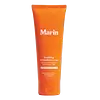What's inside
What's inside
 Key Ingredients
Key Ingredients

 Benefits
Benefits

 Concerns
Concerns

 Ingredients Side-by-side
Ingredients Side-by-side

Water
Skin ConditioningHemocyanin
AntimicrobialPersea Gratissima Fruit Butter
EmollientCetyl Alcohol
EmollientGlyceryl Stearate
EmollientGlycerin
HumectantCaprylic/Capric Triglyceride
MaskingSorbitan Oleate Decylglucoside Crosspolymer
CleansingPolyacrylamide
C13-14 Isoparaffin
EmollientLaureth-7
EmulsifyingCocos Nucifera Oil
MaskingSqualane
EmollientTocopherol
AntioxidantHyaluronic Acid
HumectantSodium Benzoate
MaskingSodium Levulinate
Skin ConditioningPotassium Sorbate
PreservativeSodium Phytate
Water, Hemocyanin, Persea Gratissima Fruit Butter, Cetyl Alcohol, Glyceryl Stearate, Glycerin, Caprylic/Capric Triglyceride, Sorbitan Oleate Decylglucoside Crosspolymer, Polyacrylamide, C13-14 Isoparaffin, Laureth-7, Cocos Nucifera Oil, Squalane, Tocopherol, Hyaluronic Acid, Sodium Benzoate, Sodium Levulinate, Potassium Sorbate, Sodium Phytate
Pramoxine Hydrochloride 1%
Water
Skin ConditioningGlycerin
HumectantPetrolatum
EmollientCetyl Alcohol
EmollientButyrospermum Parkii Butter
Skin ConditioningCetearyl Alcohol
EmollientPEG-100 Stearate
Glyceryl Stearate
EmollientIsopropyl Myristate
EmollientStearic Acid
CleansingDimethicone
EmollientPalmitic Acid
EmollientPotassium Phosphate
BufferingCeramide NP
Skin ConditioningCeramide AP
Skin ConditioningCeramide EOP
Skin ConditioningCarbomer
Emulsion StabilisingBehentrimonium Methosulfate
Sodium Hydroxide
BufferingMyristic Acid
CleansingSodium Lauroyl Lactylate
EmulsifyingCholesterol
EmollientTasmannia Lanceolata Fruit Extract
Skin ConditioningPhenoxyethanol
PreservativeDipotassium Phosphate
BufferingDisodium EDTA
Alcohol Denat.
AntimicrobialHydrolyzed Hyaluronic Acid
HumectantCitric Acid
BufferingXanthan Gum
EmulsifyingPhytosphingosine
Skin ConditioningEthylhexylglycerin
Skin ConditioningPramoxine Hydrochloride 1%, Water, Glycerin, Petrolatum, Cetyl Alcohol, Butyrospermum Parkii Butter, Cetearyl Alcohol, PEG-100 Stearate, Glyceryl Stearate, Isopropyl Myristate, Stearic Acid, Dimethicone, Palmitic Acid, Potassium Phosphate, Ceramide NP, Ceramide AP, Ceramide EOP, Carbomer, Behentrimonium Methosulfate, Sodium Hydroxide, Myristic Acid, Sodium Lauroyl Lactylate, Cholesterol, Tasmannia Lanceolata Fruit Extract, Phenoxyethanol, Dipotassium Phosphate, Disodium EDTA, Alcohol Denat., Hydrolyzed Hyaluronic Acid, Citric Acid, Xanthan Gum, Phytosphingosine, Ethylhexylglycerin
 Reviews
Reviews

Ingredients Explained
These ingredients are found in both products.
Ingredients higher up in an ingredient list are typically present in a larger amount.
Cetyl Alcohol is a fatty alcohol. Fatty Alcohols are most often used as an emollient or to thicken a product.
Its main roles are:
Though it has "alcohol" in the name, it is not related to denatured alcohol or ethyl alcohol.
The FDA allows products labeled "alcohol-free" to have fatty alcohols.
Learn more about Cetyl AlcoholGlycerin is already naturally found in your skin. It helps moisturize and protect your skin.
A study from 2016 found glycerin to be more effective as a humectant than AHAs and hyaluronic acid.
As a humectant, it helps the skin stay hydrated by pulling moisture to your skin. The low molecular weight of glycerin allows it to pull moisture into the deeper layers of your skin.
Hydrated skin improves your skin barrier; Your skin barrier helps protect against irritants and bacteria.
Glycerin has also been found to have antimicrobial and antiviral properties. Due to these properties, glycerin is often used in wound and burn treatments.
In cosmetics, glycerin is usually derived from plants such as soybean or palm. However, it can also be sourced from animals, such as tallow or animal fat.
This ingredient is organic, colorless, odorless, and non-toxic.
Glycerin is the name for this ingredient in American English. British English uses Glycerol/Glycerine.
Learn more about GlycerinGlyceryl Stearate is a mix of glycerin and stearic acid.
It is used to stabilize the mixing of water and oil ingredients. By preventing these ingredients from separating, it can help elongate shelf life. It can also help thicken the product's texture.
As an emollient, it helps soften skin and supports barrier-replenishing ingredients.
In cosmetics, Glyceryl Stearate is often made from vegetable oils or synthetically produced.
This ingredient may not be fungal-acne safe
Fun fact: The human body also creates Glyceryl Stearate naturally.
Learn more about Glyceryl StearateWater. It's the most common cosmetic ingredient of all. You'll usually see it at the top of ingredient lists, meaning that it makes up the largest part of the product.
So why is it so popular? Water most often acts as a solvent - this means that it helps dissolve other ingredients into the formulation.
You'll also recognize water as that liquid we all need to stay alive. If you see this, drink a glass of water. Stay hydrated!
Learn more about Water